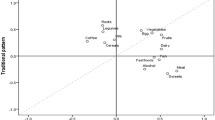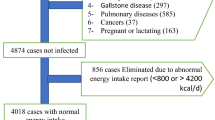Abstract
OBJECTIVE:
Assessing overall diet instead of the effects of a single nutrient on diet–disease relations may be more informative. This study was conducted to evaluate the relationship between dietary diversity score (DDS) and metabolic syndrome in Tehranian adults.
DESIGN:
Cross-sectional study.
SUBJECTS:
A representative sample of 581 healthy subjects aged over 18 y selected randomly from among participants of the Tehran Lipid and Glucose Study.
MEASUREMENTS:
Usual dietary intake was assessed using a validated semi quantitative food frequency questionnaire. DDS was calculated based on scoring to the five-food group. The DDS range was 0–10. Weight and height were measured according to standard protocols and body mass index (BMI) was calculated. Fasting blood samples were taken for biochemical measurements and blood pressure was assessed according to standard methods. Metabolic syndrome was defined according to ATPIII. Subjects were categorized based on quartile cut-points of DDS.
RESULTS:
Means (±s.d.) of age and BMI were 37±12 y and 25.7±4.3 kg/m2, respectively. Mean (±s.d.) of DDS was 6.15±1.02. The probability of having metabolic syndrome decreased with quartiles of DDS (odds ratios among quartiles: 1.00, 0.82, 0.76, 0.70, P<0.05, and odds ratios among quartiles after further adjustment for BMI: 1.00, 0.88, 0.80, 0.77, P<0.05). After controlling for confounders, a significantly decreasing trend was observed for the risk of having high blood pressure, impaired glucose homeostasis and high triglyceride levels.
CONCLUSION:
DDS had inverse association with metabolic syndrome and some of its features in this cross-sectional study. A higher dietary diversity, therefore, might be associated with lower possibility of having some metabolic disorders.
This is a preview of subscription content, access via your institution
Access options
Subscribe to this journal
Receive 12 print issues and online access
$259.00 per year
only $21.58 per issue
Buy this article
- Purchase on Springer Link
- Instant access to full article PDF
Prices may be subject to local taxes which are calculated during checkout
Similar content being viewed by others
References
Reaven GM . Banting lecture 1988. Role of insulin resistance in human disease. Diabetes 1988; 37: 1595–1607.
Azizi F, Ghanbarian A, Madjid M, Rahmani M . Distribution of blood pressure and prevalence of hypertension in Tehran adult population: Tehran Lipid and Glucose Study (TLGS), 1999–2000. J Hum Hypertens 2002; 16: 305–312.
Azizi F, Emami H, Salehi P, Ghanbarian A, Mirmiran P, Mirbolooki M, Azizi T . Cardiovascular risk factors in the elderly: the Tehran Lipid and Glucose Study. J Cardiovasc Risk 2003; 10: 65–73.
Ford ES, Giles WH, Dietz WH . Prevalence of the metabolic syndrome among US adults: findings from the third National Health and Nutrition Examination Survey. JAMA 2002; 16: 356–359.
Hollenberg NK . Genetic versus environmental etiology of the metabolic syndrome among male and female twins. Curr Hypertens Rep 2002; 4: 178.
Rimm EB, Willett WC, Hu FB, Sampson L, Colditz GA, Manson JE, Hennekens C, Stampfer MJ . Folate and vitamin B6 from diet and supplements in relation to risk of coronary heart disease among women. JAMA 1998; 279: 359–364.
Wolk A, Manson JE, Stampfer MJ, Colditz GA, Hu FB, Speizer FE, Hennekens CH, Willett WC . Long-term intake of dietary fiber and decreased risk of coronary heart disease among women. JAMA 1999; 281: 1998–2004.
Mirmiran P, Azadbakht L, Esmaillzadeh A, Azizi F . Dietary diversity score in adolescents — a good indicator of the nutritional adequacy of diets: Tehran lipid and glucose study. Asia Pacific J Clin Nutr 2004; 13: 56–60.
Hatloy A, Torheim LE, Oshaug A . Food variety — a good indicator of nutritional adequacy of the diet? A case study from an urban area in Mali, West Africa. Eur J Clin Nutr 1998; 52: 891–898.
Drewnowski A, Ahlstrom Henderson S, Driscoll A, Rolls BJ . The dietary variety score: assessing diet quality in healthy young & older adults. J Am Diet Assoc 1997; 97: 266–271.
Jorde R, Bonaa KH . Calcium from dairy products, vitamin D intake, and blood pressure: the Tromso Study. Am J Clin Nutr 2000; 71: 1530–1535.
Azizi F, Mirmiran P, Azadbakht L . Predictors of cardiovascular risk factors in Tehranian adolescents: Tehran Lipid & Glucose Study. Int J Vitam Nutr Res 2004; 74: 307–312.
Weaver CM, Heaney RP . Calcium. In: Shils M et al (eds) Modern Nutrition in Health and Disease 9th edn. Lippincott, Williams and Wilkins: Philadelphia; 1998. p 148.
Raynor HA, Epstein LH . Dietary variety, energy regulation, and obesity. Psychol Bull 2001; 127: 325–341.
Kennedy E . Dietary diversity, diet quality, and body weight regulation. Nutr Rev 2004; 62: S78–S81.
Raynor HA, Jeffery RW, Tate DF, Wing RR . Relationship between changes in food group variety, dietary intake, and weight during obesity treatment. Int J Obes Relat Metab Disord 2004; 28: 813–820.
McCollough ML, Feskanich D, Stampfer MJ, Fiovannucci EL, Rimm EB, Hu FB, Spiegelman D, Hunter DJ, Colditz GA, Willett WC . Diet quality and major chronic disease risk in men and women: moving toward improved dietary guidance. Eur J Clin Nutr 2002; 57: 930–939.
Kant AK, Schatzkin A, Ziegler RG . Dietary diversity and subsequent cause of specific mortality in the NHANESI epidemiologic follow up study. J Am Coll Nutr 1995; 14: 233–238.
Hodgson JM, Hsu-Hage BH, Wahlqvist ML . Food variety as a quantitative descriptor of food intake. Ecol Food Nutr 1994; 32: 137–148.
Wahlqvist ML, Lo CS, Myers KA . Food variety is associated with less macrovascular disease in those with type II diabetes and their healthy controls. J Am Coll Nutr 1989; 8: 515–523.
Miller WL, Crabtree BF, Evans DK . Exploratory study of the relationship between hypertension and diet diversity among Saba Islanders. Public Health Rep 1992; 107: 426–432.
Pereira MA, Jacobs Jr DR, Van Horn L, Slattery ML, Kartashov AI, Ludwig DS . Dairy consumption, obesity, and the insulin resistance syndrome in young adults: the CARDIA Study. JAMA 2002; 287: 2081–2089.
Mennen L, Lafay L, Feskens EJ, Novak M, Lepinary P, Balkau B . Possible protective effect of bread and dairy products on the risk of the metabolic syndrome. Nutr Res 2000; 20: 335–347.
Azizi F, Rahmani M, Emami H, Madjid M . Tehran Lipid and Glucose Study: rational and design. CVD Prev 2000; 3: 242–247.
Fung TT, Rimm EB, Spiegelman D, Rifai N, Tofler GH, Willett WC, Hu FB . Association between dietary patterns and plasma biomarkers of obesity and cardiovascular disease risk. Am J Clin Nutr 2001; 73: 61–67.
Kimiagar SM, Ghaffarpour M, Houshiar-Rad A, Hormozdyari H, Zellipour L . Food consumption pattern in the Islamic Republic of Iran and its relation to coronary heart disease. East Mediterr Health J 1998; 4: 539–547.
Rimm EB, Giovannucci EL, Stampfer MJ, Colditz GA, Litin LB, Willett WC . Reproducibility and validity of an expanded self administered semiquantitative food frequency questionnaire among male health professionals. Am J Epidemiol 1992; 135: 1114–1126.
Ghaffarpour M, Houshiar-Rad A, Kianfar H . The Manual for Household Measures, Cooking Yields Factors and Edible Portion of Food. Keshavarzi Press: Tehran; 1999. (in Farsi).
Kant AK, Schatzkin A, Ziegler RG, Nestle M . Dietary diversity in the US population, NHANES II, 1976–1980. J Am Diet Assoc 1991; 15: 1526–1531.
US Department of Agriculture. USDA'S Food Guide Pyramid Booklet. US Department of Agriculture: Washington, DC; 1996.
Haines PS, Siega-Riz AM, Popkin BM . The Diet Quality Index revised: a measurement instrument for populations. J Am Diet Assoc 1999; 99: 697–704.
Friedewald WT, Levy RI, Fredrickson DS . Estimation of the concentration of low- density lipoprotein cholesterol in plasma, without use of the preparative ultracentrifuge. Clin Chem 1972; 8: 499–502.
Azizi F, Rahmani M, Ghanbarian A, Emami H, Salehi P, Mirmiran P, Sarbazi N . Serum lipid levels in an Iranian adults population: Tehran Lipid and Glucose Study. Eur J Epidemiol 2003; 18: 311–319.
Mirmiran P, Mohammadi F, Allahverdian S, Azizi F . Estimation of energy requirements for adults: Tehran lipid and glucose study. Int J Vitam Nutr Res 2003; 73: 193–200.
National Cholesterol Education Program (NCEP) Expert Panel on Detection, Evaluation, and Treatment of High Blood Cholesterol in Adults (Adult Treatment Panel III). Third Report of the National Cholesterol Education Program (NCEP) Expert Panel on Detection, Evaluation, and Treatment of High Blood Cholesterol in Adults (Adult Treatment Panel III) final report. Circulation 2002; 106: 3143–3421.
Mirmiran P, Esmaillzadeh A, Azizi F . Dairy consumption and body mass index: an inverse relationship. Int J Obese Relat Metab Disord 2005; 29: 115–121.
Ascherio A, Rimm EB, Giovannucci EL, Colditz GA, Rosner B, Willett WC, Sacks F, Stampfer MJ . A prospective study of nutritional factors and hypertension among US men. Circulation 1992; 86: 1475–1484.
Kotchen TA, Kotchen JM . Nutrition, diet and blood pressure. In: Shils M, et al (eds) Modern Nutrition in Health & Disease, 9th edn. Lippincott, Williams and Wilkins: Philadelphia; 1999. pp 1217–1228.
Torheim LE, Ouattara F, Diarra MM, Thiam FD, Barikmo I, Hatloy A, Oshaug A . Nutrient adequacy and dietary diversity in rural Mali: association and determinants. Eur J Clin Nutr 2004; 58: 594–604.
Fernandez E, Negri E, La Vecchia C, Franceschi S . Diet diversity and colorectal cancer. Prev Med 2000; 31: 11–14.
La Vecchia C, Munoz SE, Braga C, Ferandez E, Decarli A . Diet diversity and the risk of colorectal cancer in northern Italy. Cancer Epidemiol Biomarkers Prev 1996; 5: 433–436.
Acknowledgements
We express our appreciation to the participants of the Tehran Lipid and Glucose Study for their enthusiastic support and the staff of the Endocrine Research Center, Tehran Lipid and Glucose Study unit for their valuable help in the conducting of this study. We acknowledge greatly Dr LE Torheim, from Akershus University College, Lillestrom, Norway, for sharing with us his valuable PhD thesis and papers in the field of dietary diversity score.
Author information
Authors and Affiliations
Corresponding author
Additional information
LA and PM designed the study, collected and analyzed the data and wrote the manuscript. FA supervised the research.
Rights and permissions
About this article
Cite this article
Azadbakht, L., Mirmiran, P. & Azizi, F. Dietary diversity score is favorably associated with the metabolic syndrome in Tehranian adults. Int J Obes 29, 1361–1367 (2005). https://doi.org/10.1038/sj.ijo.0803029
Received:
Revised:
Accepted:
Published:
Issue Date:
DOI: https://doi.org/10.1038/sj.ijo.0803029
Keywords
This article is cited by
-
Association between plant-based diets and metabolic syndrome in obese adults from Iran: a cross-sectional study
BMC Endocrine Disorders (2023)
-
Metabolic syndrome distributions in dietary diversity score groups and its associated factors among adults in the urban community of Jimma, Southwest Ethiopia: a community based cross- sectional study
BMC Endocrine Disorders (2022)
-
Dietary diversity score and cardio-metabolic risk factors: an updated systematic review and meta-analysis
Eating and Weight Disorders - Studies on Anorexia, Bulimia and Obesity (2022)
-
Dietary diversity and food security status among heart failure patients in the north of Iran
BMC Nutrition (2021)
-
Association of dietary diversity score (DDS) and migraine headache severity among women
Neurological Sciences (2021)



